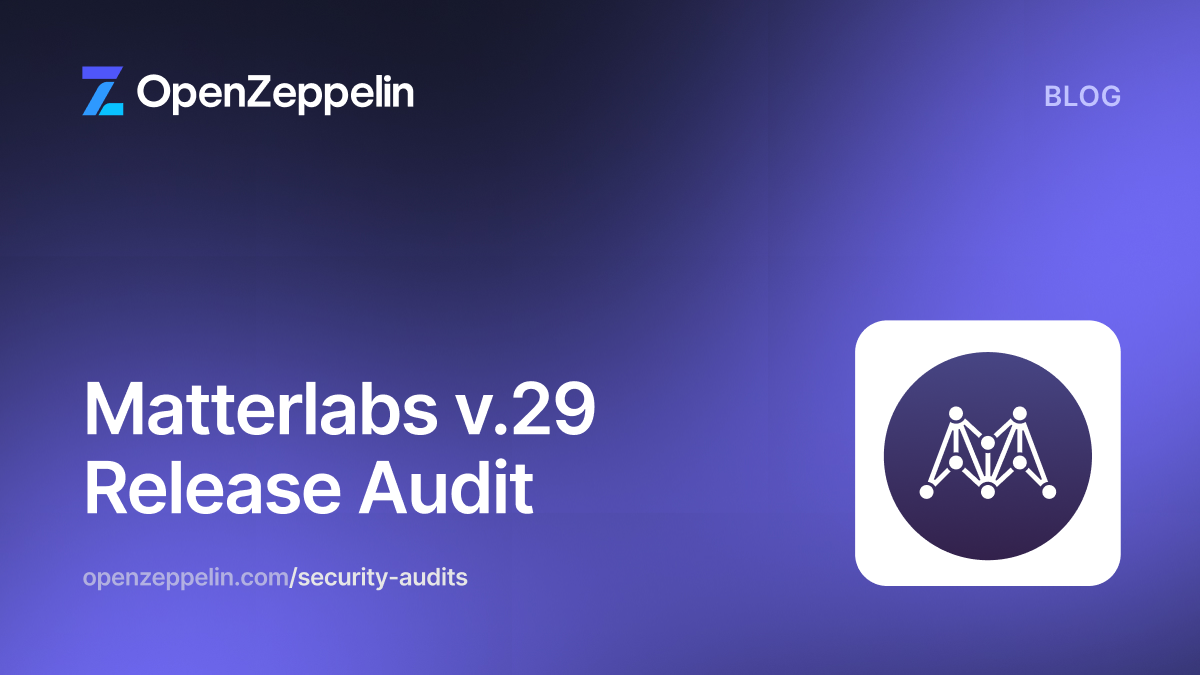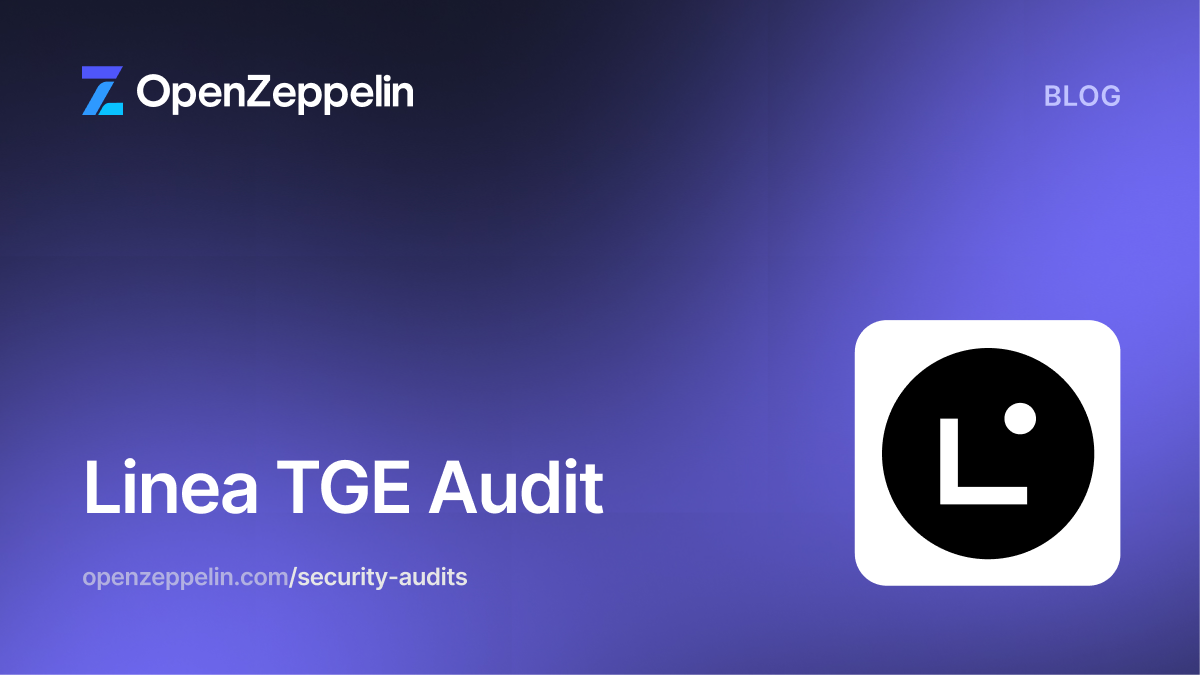Table of Contents
- Table of Contents
- Summary
- Scope
- System Overview
- Summary of Changes
- Security Model and Trust Assumptions
- Medium Severity
- Low Severity
- RequestL2Range Does Not Return Error if Channel Is Full
- Witness Data Reader Skips the Last Line if There Is No New Line
- Missing Type Conversion
- Tests Panic and Fail
- Lack of Input Validation
- The Mantle DA Status Is Not Cleared on OP-Batcher Start
- Sleep Is Used to Wait for Channel Readiness
- Missing Connection Timeout for Contacting Mantle DA
- Unencrypted Connection to Mantle DA
- Notes & Additional Information
- Conclusion
Summary
- Type
- Layer 2
- Timeline
- From 2024-02-12
- To 2024-02-28
- Languages
- Go
- Total Issues
- 12 (3 resolved)
- Critical Severity Issues
- 0 (0 resolved)
- High Severity Issues
- 0 (0 resolved)
- Medium Severity Issues
- 1 (1 resolved)
- Low Severity Issues
- 9 (0 resolved)
- Notes & Additional Information
- 2 (2 resolved)
Scope
We audited three pull requests with the op-node, op-batcher, op-proposer, op-chain-ops, and op-service components being in scope:
Pull request #72 from the base commit at 68f2533 and the head commit at bb0ff70. In scope were the following files:
mantle-v2
├── op-batcher
│ ├── batcher
│ │ ├── batch_submitter.go
│ │ ├── channel_manager.go
│ │ ├── config.go
│ │ ├── driver_da.go
│ │ └── driver.go
│ ├── common
│ │ ├── types.go
│ │ └── utils.go
│ ├── flags
│ │ └── flags.go
│ └── metrics
│ ├── metrics.go
│ └── noop.go
├── op-chain-ops
│ ├── cmd
│ │ ├── check-migration
│ │ │ └── main.go
│ │ ├── op-migrate
│ │ │ └── main.go
│ │ ├── rollover
│ │ │ └── main.go
│ │ └── withdrawals
│ │ └── main.go
│ ├── crossdomain
│ │ ├── encoding.go
│ │ ├── hashing.go
│ │ ├── legacy_abi.go
│ │ ├── legacy_withdrawal.go
│ │ ├── message.go
│ │ ├── migrate.go
│ │ ├── params.go
│ │ ├── withdrawal.go
│ │ ├── withdrawals.go
│ │ └── witness.go
│ ├── eof
│ │ └── eof_crawler.go
│ ├── ether
│ │ ├── addresses.go
│ │ ├── cli.go
│ │ ├── migrate.go
│ │ └── storage.go
│ ├── genesis
│ │ ├── check.go
│ │ ├── config.go
│ │ ├── db_migration.go
│ │ ├── genesis.go
│ │ ├── layer_one.go
│ │ ├── layer_two.go
│ │ └── setters.go
│ ├── immutables
│ │ └── immutables.go
│ └── util
│ └── util.go
├── op-node
│ ├── chaincfg
│ │ └── chains.go
│ ├── cmd
│ │ └── genesis
│ │ └── cmd.go
│ ├── eth
│ │ ├── sync_status.go
│ │ └── types.go
│ ├── flags
│ │ └── flags.go
│ ├── metrics
│ │ └── metrics.go
│ ├── node
│ │ ├── config.go
│ │ └── node.go
│ ├── rollup
│ │ ├── da
│ │ │ └── datastore.go
│ │ ├── derive
│ │ │ ├── attributes.go
│ │ │ ├── calldata_source.go
│ │ │ ├── channel_bank.go
│ │ │ ├── channel_in_reader.go
│ │ │ ├── deposit_log.go
│ │ │ ├── engine_consolidate.go
│ │ │ ├── engine_queue.go
│ │ │ ├── error.go
│ │ │ ├── frame.go
│ │ │ ├── l1_block_info.go
│ │ │ ├── l1_retrieval.go
│ │ │ ├── l2block_util.go
│ │ │ ├── payload_util.go
│ │ │ ├── pipeline.go
│ │ │ └── system_config.go
│ │ ├── driver
│ │ │ ├── driver.go
│ │ │ └── state.go
│ │ ├── sync
│ │ │ ├── config.go
│ │ │ └── start.go
│ │ └── types.go
│ ├── service.go
│ ├── service_mantle.go
│ ├── sources
│ │ └── sync_client.go
│ └── withdrawals
│ └── utils.go
└── op-service
├── crypto
│ └── signature.go
└── txmgr
└── cli.go
Pull request #89 from the base commit at 5e3886c and the head commit at 76959dd. In scope were the following files:
mantle-v2
└── op-node
└── rollup
└── derive
├── deposit_log.go
└── l1_block_info.go
Pull request #98 from the base commit at 0f0861b and the head commit at 365f02a. In scope were the following files:
mantle-v2
└── op-chain-ops
├── genesis
│ └── config.go
└── immutables
└── immutables.go
System Overview
Mantle V2 is a layer 2 (L2) scaling solution for Ethereum that uses fraud proofs instead of validity proofs for its security. The protocol aims to provide low transaction fees and high throughput while maintaining full EVM compatibility. Mantle V2 is built on top of Ethereum using the OP Stack and therefore shares many similarities with Optimism. The op-node, op-batcher, and op-proposer components collectively comprise the consensus layer that keeps the chain running and glues all the other layer 1 and layer 2 components together (though there is no consensus as per the Ethereum understanding). Adding op-geth to this set, which is the execution layer, makes up the Mantle network.
The op-node component is responsible for deriving the layer 2 blockchain which means that it listens for specific layer 1 events and layer 2 transactions, and keeps the chain running by continuously grouping this data into batches and passing them to the execution client in order to produce layer 2 blocks. The op-batcher component, in turn, listens to op-node for fresh batches, groups the batches into channels, compresses them, splits them into frames, and posts frames to the data availability layer.
The op-proposer component listens to op-node for the so-called layer 2 output roots which are Merkle roots. These are then posted to the layer 1 so that the smart contracts on layer 1 can receive messages from layer 2. This includes ERC-20 token bridging as well as general message passing. The op-chain-ops component is a tool that facilitates the administration of the chain. The op-service component contains common utilities used by other parts of the codebase.
Summary of Changes
Presented below is a summary of changes to the in-scope components grouped by pull request and component.
Pull Request #72
op-node
- MantleDA is now used as a data availability provider. Prior to that, Ethereum calldata was used.
- The base fee parameter was introduced. It is set in the
SystemConfigcontract on Ethereum and then passed to the execution layer as part of the first transaction of each L2 block along with otherSystemConfigparameters. - The
requestsChannelBufferSizeconstant was increased from 128 to 1024 and the logic around handling the corresponding channel was changed. - The
unsafeL2PayloadsChannelBufferSizeconstant was increased from 10 to 4096 and the logic around handling the corresponding channel was changed. - Several improvements were merged from the upstream repository.
op-batcher
- MantleDA is now used as a data availability provider. Prior to that, Ethereum calldata was used.
op-proposer
- No changes
op-chain-ops
- Support for the
GasPriceOraclecontract was added. - Support for MNT as a native token was added.
op-service
- The updates to the
op-servicecomponent encompass support for the Key Management Service (KMS) from the Google Cloud Platform (GCP) in Ethereum operations. In case the Cloud HSM is expected to be used, new configuration parameters have been introduced to streamline the process.
Pull Request #89
op-node
- The new version of the deposited transaction event was added. In particular, the marshal and unmarshal functionality was added.
op-batcher, op-proposer, op-chain-ops, and op-service
- No changes.
Pull Request #98
op-chain-ops
- The
L1_MNT_ADDRESSconstant was added.
op-node, op-batcher, op-proposer, and op-service
- No changes.
Security Model and Trust Assumptions
MantleDA was treated as a black-box during this engagement as we were not provided with access to the documentation, tests, or the development instance of the system. Similarly, it was also assumed that the in-scope code uses MantleDA correctly.
Having said that, MantleDA is an emerging technology and thus has a higher chance of having bugs. The current way to recover from a MantleDA outage or malfunctioning is to stop the sequencer, switch data availability to Ethereum calldata in the configuration file, and start the sequencer again. This means there is no automatic fallback mechanism and, in case such an outage happens, the Mantle blockchain loses liveness until the sequencer is restarted with the new config.
Privileged Roles
The op-batcher component uses a private key to interact with the MantleDA contract which defines which MantleDA blobs should be used to derive the layer 2 chain.
Medium Severity
Data With Id 1 Cannot Be Retrieved From Mantle DA
The RetrievalFramesFromDa function of OP-Node implements the logic for retrieving frames from Mantle DA. It requires a dataStoreId value, which undergoes a check to verify if it is equal to or smaller than 0. As the calldata_source calls RetrievalFramesFromDa with the dataStoreId decreased by 1, attempting to retrieve data from Mantle DA with a dataStoreId equal to 1 becomes impossible.
Consider removing the check from the RetrievalFramesFromDa function to permit the processing of a dataStoreId with a value of 0. In addition, since the dataStoreId is of type uint32 and so cannot be smaller than 0, the check becomes unnecessary.
Update: Resolved in pull request #117.
Low Severity
RequestL2Range Does Not Return Error if Channel Is Full
The RequestL2Range function queues a range of L2 blocks and returns early if the channel is full. However, it does not return an error in this case which means that the partial data will be processed.
Consider returning an error in case the channel is full in order to make callers aware.
Update: Acknowledged, not resolved. The Mantle team stated:
Not a valid issue.
Witness Data Reader Skips the Last Line if There Is No New Line
The ReadWitnessData function of OP-Chain-Ops utilizes bufio's NewReader to iterate through the file and retrieve all entries. To read each line, the function employs ReadString, which reads until a new line is encountered. However, this approach poses an issue – if the last line of the file lacks a new line character (as is the case for text file witness.txt), the reader will trigger an EOF error, causing an early break from the loop failing to read the last line.
Consider redesigning the function logic in such a way the last line will be read correctly even if it does not end with a new line.
Update: Acknowledged, not resolved. The Mantle team stated:
Acknowledged, only used for upgrading, will not fix it.
Missing Type Conversion
The NewWithdrawal function of OP-Chains-Ops returns a Withdrawal struct with filled values. The Data field, which is of type hexutil.Bytes, is assigned data of type []byte. However, the assigned value should first be converted to the correct type using the hexutil.Bytes function.
Consider converting the data parameter to the hexutil.Bytes type.
Update: Not resolved. The Mantle team stated:
Not a valid issue.
Tests Panic and Fail
The proposed changes are not thoroughly covered by the test suite. In addition, there are multiple tests that fail, making it difficult to confirm the correctness of the implementation. The following components require additional testing:
- op-node
- op-batcher
- op-chain-ops
Consider reviewing the test suite for the above mentioned components to improve code quality.
Update: Not resolved.
Lack of Input Validation
The BaseFee parameter of type big.Int is checked for not being nil. However, a big.Int can be a negative number which does not make sense for BaseFee given that it should always be positive.
Consider checking the BaseFee parameter both for not being nil and being a positive number just like other big.Int parameters (e.g., chain ids are validated to be greater than 0 and not equal to 0).
Update: Acknowledged, will resolve.
The Mantle DA Status Is Not Cleared on OP-Batcher Start
Upon starting the OP-Batcher, the state is cleaned but the Mantle DA status is not.
Consider calling the clearMantleDAStatus function to clear the Mantle DA status.
Update: Acknowledged, not resolved.
Sleep Is Used to Wait for Channel Readiness
The sleep is used to wait 0.1 ms for sequencerCh and stepReqCh to be ready. While this might mitigate the issue in the testing environment, it might behave differently in the production environment where load might be different and thus the sleep time might not provide the desired effect.
Consider refactoring the code to avoid using sleep and instead using more reliable mechanisms to sync the channels.
Update: Not resolved. The Mantle team stated:
Not a valid issue.
Missing Connection Timeout for Contacting Mantle DA
The implemented connection to Mantle DA is missing a defined timeout option. This might lead to issues when servers accept connections but fail to respond to calls. There are the following occurrences of connections to Mantle DA:
- Connection to Mantle DA in
getFramesByDataStoreIdof OP-Node - Connection to Mantle DA Indexer in
getFramesFromIndexerByDataStoreIdof OP-Node - Connection to Mantle DA Disperser in
callEncodeof OP-Batcher
Consider adding a timeout mechanism to the above listed connections.
Update: Acknowledged, will resolve.
Unencrypted Connection to Mantle DA
The implemented connection to Mantle DA is unencrypted. In a production environment, it is generally recommended to encrypt the connection. There are the following occurrences of unencrypted connections to Mantle DA:
- Connection to Mantle DA in
getFramesByDataStoreIdof OP-Node - Connection to Mantle DA Indexer in
getFramesFromIndexerByDataStoreIdof OP-Node - Connection to Mantle DA Disperser in
callEncodeof OP-Batcher
Consider using encrypted connection instead.
Update: Acknowledged, will resolve.
Notes & Additional Information
Typographical Errors
Throughout the codebase, several typographical errors were found:
- The constant name
TxConfirmDataSubmiitedshould beTxConfirmDataSubmitted. - The comment
openendshould beopened. - This
commentshould beL1_MANTLE_TOKENnotL1_MANTLE_TOEKN.
Consider addressing the above typographical errors.
Update: Resolved in pull request #124.
Code Clarity
Throughout the codebase, several instances of redundant and unclear code were identified:
- The
NewMantleDataStorefunction defined indatastore.goalways returnserrorasnil. Thus, it is not necessary to return it and check it later. - The
NewMantleDataStoreConfigfunction returns a config and an error. However, the error is alwaysnilwhich makes returning an error unnecessary. - The
MockDataStoreConfigvariable is not used anywhere and should be removed. - The
marshalDepositVersion1function is not used anywhere and can be removed. - The data from reply is retrieved twice in the
getFramesByDataStoreIdfunction. Consider callingGetDataonce and then use it inlog.Debugand the return statement. - The data from reply is retrieved twice in the
getFramesFromIndexerByDataStoreIdfunction. Consider callingGetDataonce and then use it inlog.Debugand the return statement. - The two
ifstatements check for theBaseFeenot being equal to0. Consider moving the secondifstatement inside the firstifstatement block and removing the unnecessary check. - The
ds.cfg.MantleDaSwitchifstatement could be easier to read if it used anifstatement with only true and false branches where the true branch contained code for handling MantleDA and theelsebranch contained code for Ethereumcalldata. - One of the significant updates to the codebase was addition of the MNT value which changed the protocol to handle
MNTValueandETHValue. The correct encoding starts with theMNTValueparameter followed byETHValueparameter. However, in multiple places, the structures are initilaized in the reverse order. While this does not cause an issue since the parameter names are used, it does hinder readability. Consider changing the order of theMNTValueandETHValueparameters in theDecodeandWithdrawalTransactionfunctions.
Update: Resolved in pull request #125.
Conclusion
The audit uncovered one issue of medium severity, in addition to several other issues of a lower severity. Various recommendations have been provided to enhance the quality and documentation of the codebase. We also strongly recommend that Mantle implements more extensive QA procedures and tests before going live to prevent potentially undiscovered vulnerabilities from being exploited. This is especially crucial in areas of the code where testing was limited, such as the integration with Mantle DA. The Mantle team was very supportive throughout the audit period and answered questions in a timely manner.


